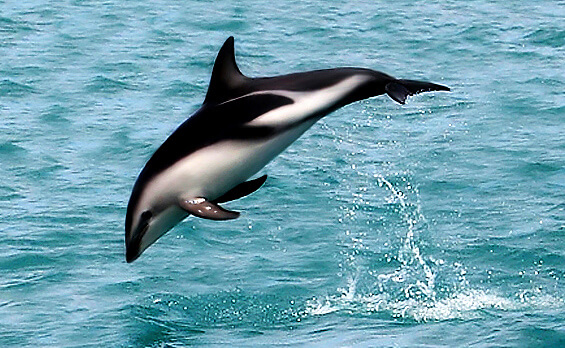The dusky dolphin is a dolphin seen in coastal waters inside the Southern Hemisphere. The dolphin’s specific epithet is basically Latin or "dark" or "dim". The animal breed is genetically associated to the Pacific white-sided dolphin; however, prevailing scientific consensus states that they are distinct species.
Dusky Dolphin Facts and Information
- Dusky dolphins like cool to cold waters
- They are famous for travelling far distances and they do not depict any dissimilar migration patterns
- The dolphins are famous for their highly acrobatic behaviours, carrying out a combination of flips, leaps, turns, and rolls
- They can learn how to carry out above tricks by observing more experienced dolphins during their play time
- The animal belongs to the toothed whale family as they have a kind of teeth which are utilized to grab the prey and avoid it from escaping
Diet
When the matter comes to food choice, it is found that the dusky dolphin eats a range of small fish and squid. In addition to that, their common foods are lantern fish, red cod, horse mackerel, anchovies, and hoki.

Habitat
The habitat of Dusky dolphins is cool waters near continental shelves. Basically, they hail from the habitat consisting of coastal waters inside the Southern Hemisphere.
Also read:
Behaviour
Dusky dolphins are found to be extremely sociable, living together in groups named pods, which inside the Kaikoura region can comprise of persons in range of 100 to 1,000 or higher in a pod. These dolphins are famously known amongst the major acrobatic of the various dolphin species. Moreover, their stunning leaps, jumps, back flips and side slaps convey enjoyment to majority of people that go out to observe their untamed and free behaviour.
Lifestyle
Dusky dolphins frequently live in big pods which could effortlessly surpass 100 dolphins as well as in certain cases some might number to the thousands. The biggest groups of the dolphins frequently occur while hunting for food and are usually smaller when resting, travelling, or doing other social activities.
The dolphins are found to be very active and can be observed playing collectively and doing several aerial acrobatics. Many people believe that these Dusky dolphins are not born with the skill; however, such skills are developed by noticing skilled dolphins perform.

Lifecycle
Life span of the dusky dolphin is known to be anywhere in range from 20 to 25 years. Most Dusky Dolphin calves are born between late winter and early summer, from October to February. Females give birth to a single offspring after a gestation period of approximately 11 months. It is known that the Dusky Dolphin calf is usually fed on the nutritious milk supplied by its mother till it is imparted to hunt on her after a year.
Predators
Though the dusky dolphin has certain predators, the animals are identified to be seldom hunted and assaulted by gigantic sharks as well as killer whales. Moreover, their food supply is occasionally endangered by sharks who try to pinch the food they have hunted after their food has been collected into a tight ball around the water surface.
Breeding
Dusky dolphins are known to begin mating when they are of age of 6 to 8 years. The typical gestation period usually continues from 12 – 13 months particularly for female dolphins and the pregnancy takes place once each 2 1/2 – 3 years. Once they give birth, mother dolphins might nurse their offspring for period up to 12 months directly feeding them milk from their mammary glands.
Appearance
The average weight of this animal is 60 to 90 kg and their maximum size ranges from 5cm and 195cm within New Zealand. The similar species inside South America are found to grow bigger, with records of dolphins known to be more than 2 metres in length.
Similar to other species of cetacean, Dusky Dolphins possess a smooth and hairless body, which assists them to move smoothly through the water. Moreover, the animal is powered through their two tail flukes which basically lay horizontally, identical to that of fish. It came to know that their upper body part is dark grey or blue-black coloured. Besides, the part is isolated from their light grey part through grey line which continues from their mouth to the bottom of their tail. In addition to that, the animal also possesses two light grey coloured lines running diagonally from their tail part towards their dorsal fin.

Life Span
The life span of Dusky Dolphin is maximum 25 years and they reproduce many offspring during this.
Health Issues
The dolphins do not face any major health issues except minor infections around the gills. Moreover, they are prone to get infections around their tails.
Grooming
Most of the time, their body is clean and so minimal grooming is required. It is their continuous presence in water that makes them clean every time. However, the one who owns it need to clean them up by let them bath, clean their gills, tails, eyes, etc. on regular basis.
Shedding
The dolphins shed minimum as their body is hairless.
Characteristics
- Dusky dolphins are found to be a well-known attraction for whale-watching tours
- From 1997, it came to notice that the dolphin-watching conduct have enlarged in Patagonia, with dusky dolphins being the target species
- The dolphin is famous for its extraordinary acrobatics, showing lots of different aerial behaviour
- Their status is unknown; however, it has been usually seen in gill nets
- They possess unique body shape and this suggests that it is very flexible in the world of agile species of different dolphins
- The dolphins are frequently seen coming out of the water while swimming as well as playing
- The noise which is created by them while diving back inside the water is capable to travel for maximum distance of 1km across the water and maximum distance of 3km over the air
- They can easily catch their predators from few kilometre distance away






